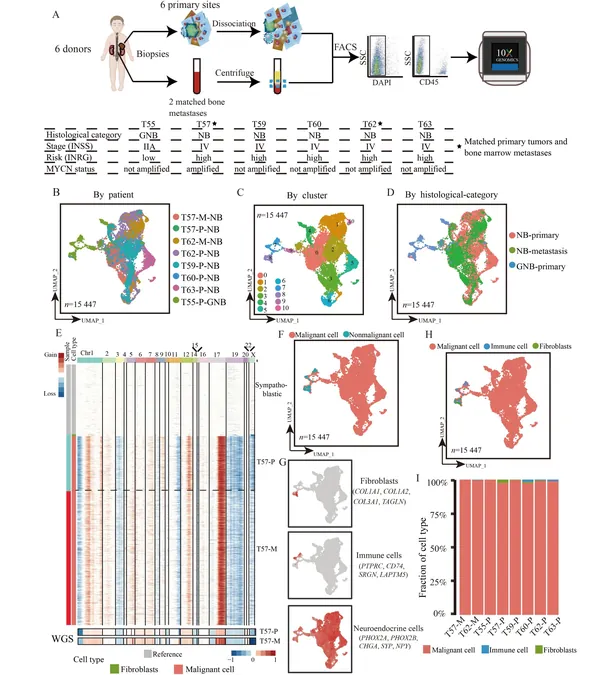
Breakthrough Study Unveils Key Cell Type and Gene Signature Driving Neuroblastoma Metastasis
2024-11-04
Author: Wei Ling
Neuroblastoma (NB) stands as the most common extracranial solid tumor found in children, representing a daunting therapeutic challenge due to its propensity for metastasis and pronounced heterogeneity. A groundbreaking study utilizing single-cell RNA sequencing (scRNA-seq) has unveiled crucial molecular mechanisms that underpin the progression and spread of NB, suggesting promising new avenues for targeted therapy.
Study Overview
Published in the esteemed journal Frontiers of Medicine, this study delved into the analysis of primary tumoral tissues alongside matched metastatic samples derived from NB patients. In a striking discovery, researchers identified a unique cell subpopulation dubbed 'starter' cells, which appear to play a pivotal role in initiating metastases.
Analytical Techniques
Employing sophisticated analytical techniques including evolutionary trajectory analysis and predictions of cell-state differentiation, the researchers comprehensively mapped the transcriptional landscape of NB, pinpointing a gene signature closely associated with poor patient prognosis.
Patient Samples
The investigation focused on tumor samples obtained from six NB patients, encompassing both primary tumors and metastatic sites. Through scRNA-seq, a detailed expression atlas of single cells was created, revealing 11 distinct cellular clusters, each with its own transcriptional profile, emphasizing the heterogeneity that characterizes this aggressive cancer.
Cellular Analysis
Using inferred copy number variation (CNV) analysis alongside whole genome sequencing (WGS), malignant and non-malignant cells were effectively distinguished, enriching the understanding of tumor cell populations in this context.
Starter Cells
Notably, trajectory analysis isolated a cluster of cells termed starter cells, recognized as potential initiators of neuroblastoma's spread. These cells displayed heightened proliferative potential and were marked by active cell cycle and DNA repair processes. Additionally, the starter cells exhibited signs of partial epithelial-to-mesenchymal transition (EMT), a characteristic linked with increased migration and invasive capabilities in cancer cells, reinforcing their role in metastasis.
Tumor Microenvironment
To further explore the tumor microenvironment's dynamics, researchers examined the scRNA-seq data from non-malignant cells surrounding the tumor. They observed significant interactions, particularly through the TGFβ signaling pathway, between the starter cells and various immune and stroma cell types. This complex interplay hints at a network of communications that may affect tumor evolution and its capacity to evade immune responses.
150-Gene Signature
A significant breakthrough from this study is the identification of a 150-gene 'starter cell' signature, universally linked with unfavorable clinical outcomes across various datasets. The robustness of this signature's predictive capability in forecasting adverse prognoses across diverse sequencing methodologies and patient cohorts showcases its potential for clinical application.
Limitations and Future Directions
While the study does mention some limitations, particularly the small sample size stemming from difficulties in obtaining paired primary and metastatic samples, the results were validated through public datasets and other experimental techniques, strengthening the claims made by the researchers.
Conclusion
In conclusion, this comprehensive study offers an invaluable molecular blueprint detailing the metastatic journey of neuroblastoma, spotlighting a crucial cell subpopulation and its gene signature that may inform future therapeutic strategies. This deep dive into the cellular and molecular intricacies of NB not only promises to enhance prognostic assessments but also paves the way for targeted interventions in this challenging pediatric cancer landscape.



 Brasil (PT)
Brasil (PT)
 Canada (EN)
Canada (EN)
 Chile (ES)
Chile (ES)
 Česko (CS)
Česko (CS)
 대한민국 (KO)
대한민국 (KO)
 España (ES)
España (ES)
 France (FR)
France (FR)
 Hong Kong (EN)
Hong Kong (EN)
 Italia (IT)
Italia (IT)
 日本 (JA)
日本 (JA)
 Magyarország (HU)
Magyarország (HU)
 Norge (NO)
Norge (NO)
 Polska (PL)
Polska (PL)
 Schweiz (DE)
Schweiz (DE)
 Singapore (EN)
Singapore (EN)
 Sverige (SV)
Sverige (SV)
 Suomi (FI)
Suomi (FI)
 Türkiye (TR)
Türkiye (TR)
 الإمارات العربية المتحدة (AR)
الإمارات العربية المتحدة (AR)